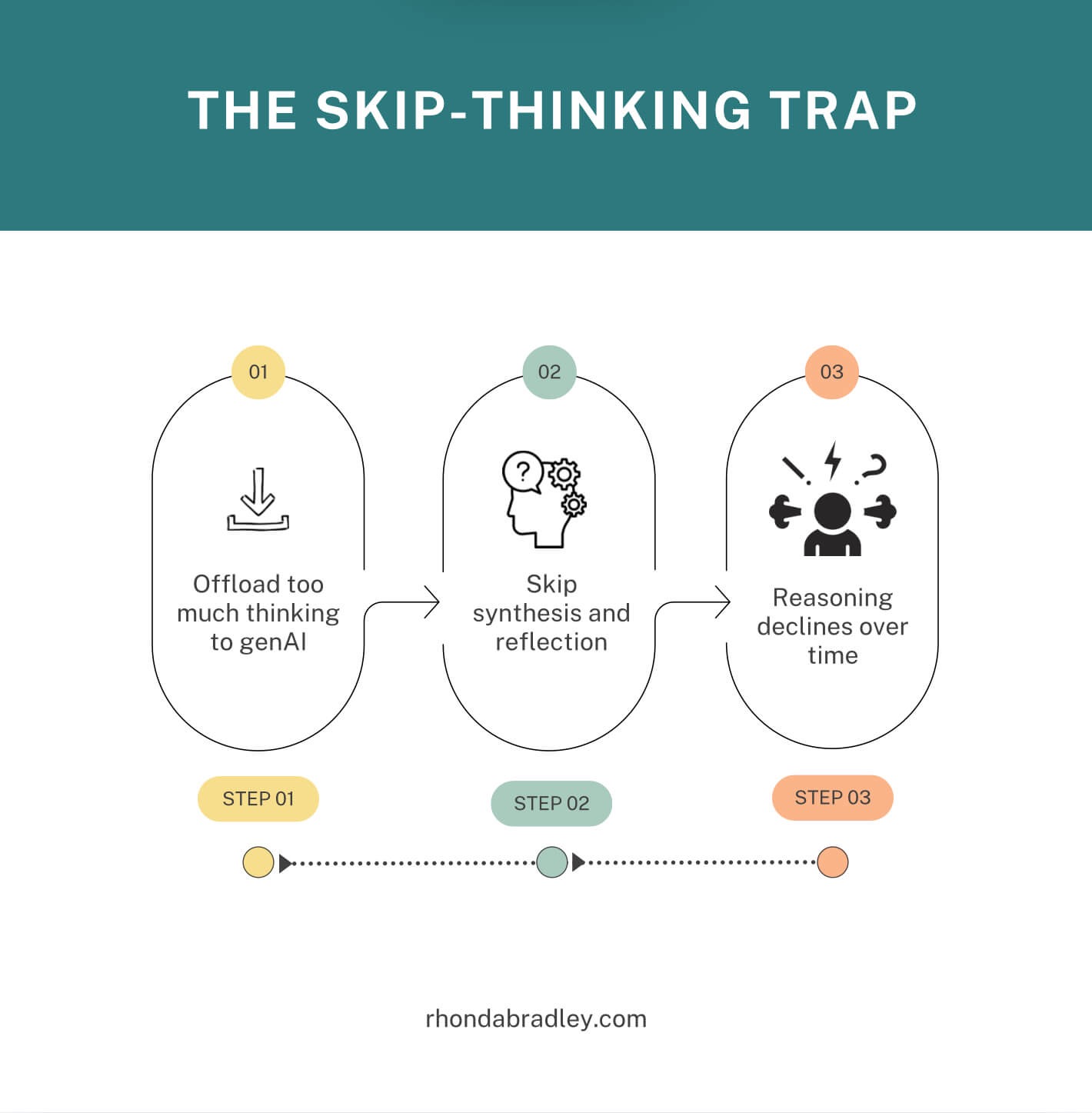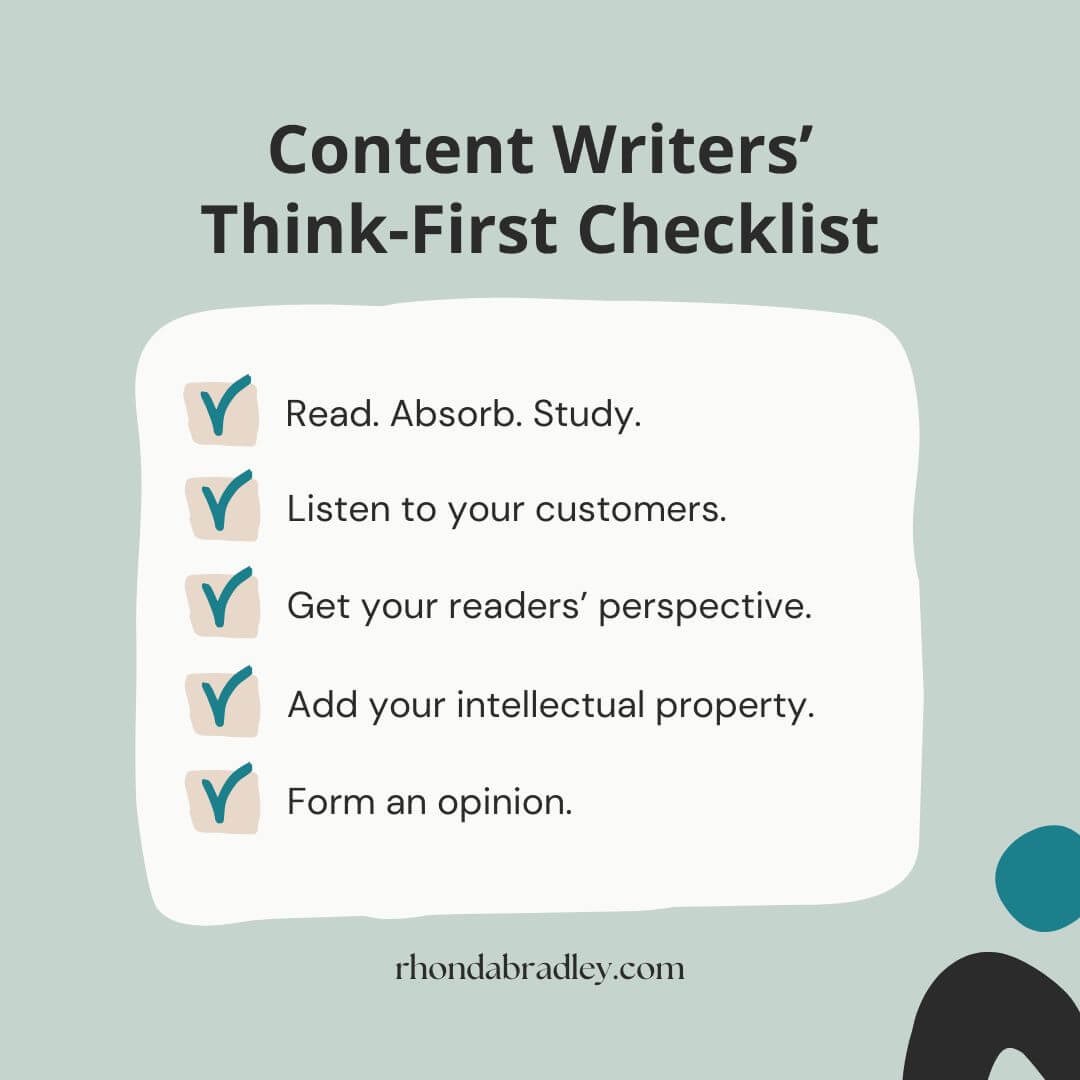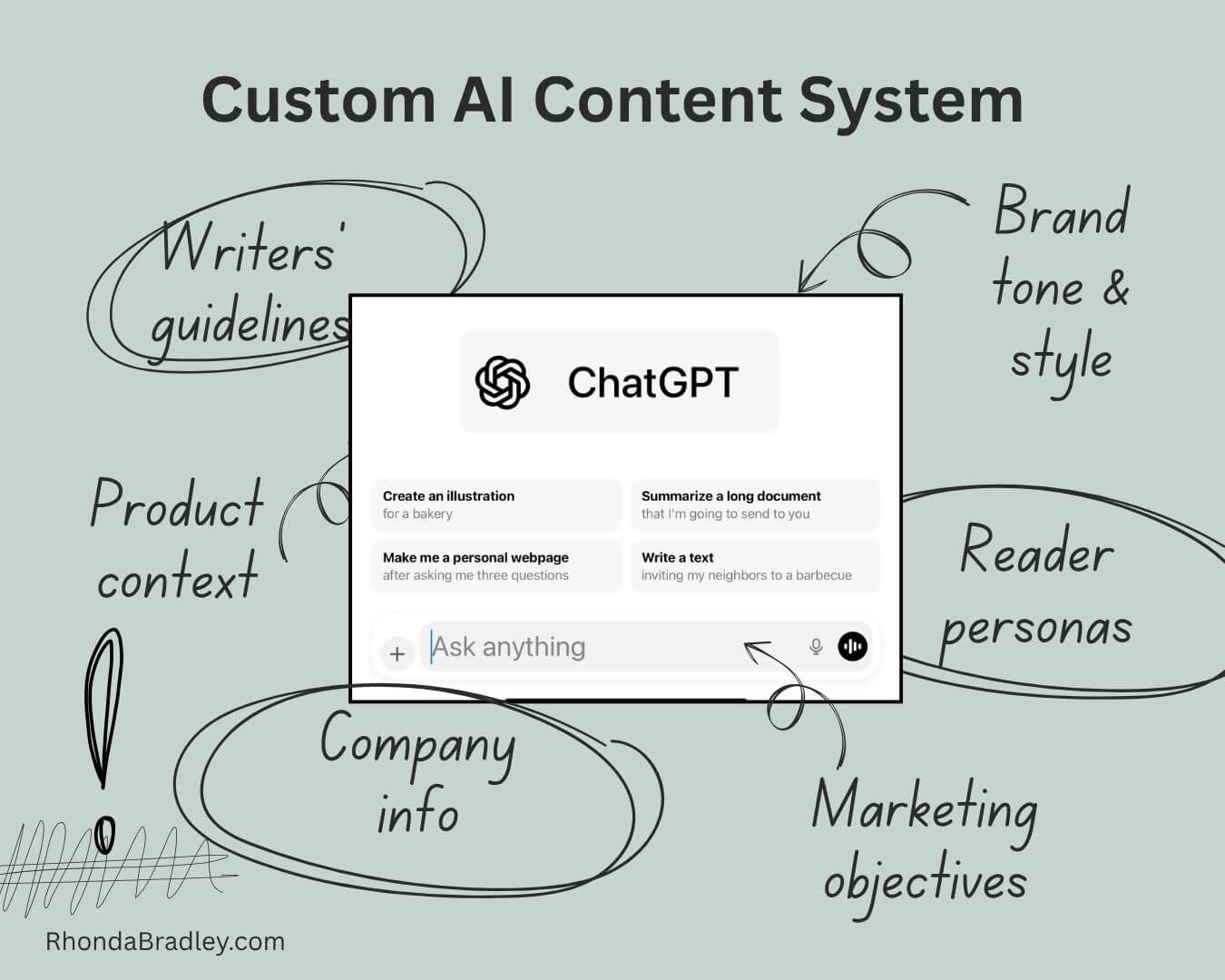
Think-First Workflows: The Smarter Way to Scale Efficiency, ROI, and Strategic AI Content
Salesforce’s latest State of Marketing report names AI implementation as both marketers’ top priority and their biggest challenge.
Many B2B teams live in that gap.
You’re testing AI, but the workflows feel scattered, the content sounds “so-so,” and the promised efficiency never shows up.
After a decade in B2B content, I’ve spent the last two years developing a hybrid system that closes that gap. The Think-First Workflow is a practical method to consistently improve writing efficiency by 30–50% while producing high-value content for your target audience.
Get the two-stage process below.
The Performance Gap
Top-performing marketers are 2.5 times more likely to fully implement AI, according to Salesforce. Yet a recent Upwork report states that 77% of employees say AI tools have reduced their productivity.
AI adoption keeps accelerating, but most marketing teams still fail to realize its potential. That gap exposes a deeper problem: an industry-wide misunderstanding of how to use the tool.
It’s also why so much AI-assisted content sounds flat, reads generic, and fails to perform.
AI misuse weakens your team’s judgment and critical thinking skills. Treat it like a real business risk and design against it.
To protect content performance, build a process that strengthens critical thinking and embeds reasoning and judgment into your workflow.
The Skip-Thinking Trap
GenAI saves time, but used the wrong way, it can quietly cost you revenue.
When teams offload too much thinking to LLMs, both quality and results fall.
Psychologists call this cognitive offloading. It’s not new, but AI makes it dangerously easy.

In marketing, cognitive offloading happens when teams rush to prompt instead of pausing to think. I call this the Skip-Thinking Trap.
The Skip-Thinking Trap begins the moment your team accepts a “good enough” draft and slides into the role of content reviewer instead of director.
This trap isn’t theoretical.
A 2024 study in Computers in Human Behavior captured what happens when people fall into it.
Researchers asked students to use an LLM for a research task. The tool made the work so efficient that it wasn’t “cognitively challenging enough” to trigger deep processing.
They skipped the heavy lifting of poring through sources, comparing ideas, and building arguments.
The result: those who used AI produced lower-quality content and showed weaker reasoning than the group who did the mental work themselves.
What that study showed in a 20-minute student task mirrors what happens inside teams every day.
It’s the same workflow I call “prompt and pray.” You prompt, copy, paste, polish a little, and skip the essential human step of forming an original point of view.
That habit doesn’t just hurt ROI. It erodes your team’s critical thinking and reasoning skills.
And the longer it continues, the harder it becomes to reverse.
The Solution: “Think-First Workflows”
A think-first workflow is a human-led approach to GenAI.
It replaces the typical prompt-and-pray process by building a workflow that requires your team to use critical thinking skills before prompting.
Instead of chasing speed alone, it hardwires critical thinking and creative judgment into the early part of the process, then uses AI to accelerate your team’s expertise.
When paired with a brand-programmed AI system, this hybrid workflow cuts total writing time by 30–50% while producing sharper, more competitive content.
Why isn’t this approach more common?
Because it demands a shift most teams haven’t yet made.
It requires a change in thinking.
Many have fallen into a “prompt-first” habit. A think-first approach forces your team to exercise its critical thinking, judgment, and reasoning skills before turning to AI.
It treats GenAI as part of the process instead of the full solution.
Most leaders approach LLMs as plug-and-play tools. Real efficiency happens when you redesign the workflow to assist your team instead of leading it.
The solution is a human-led, hybrid workflow that turns your team’s expertise into a repeatable system.
Think-First Workflow: The Blueprint
Stage 1: Build Your Angle

Here’s what the process looks like:
- Go to the source. Read original research and data, not summaries or competitor recaps. Study the topic instead of skimming your way through it.
- Listen to your customers. Track their exact questions and recurring pain points.
- Find the contradictions. Spot the patterns or assumptions your industry keeps getting wrong.
- Add your intellectual property. Pull in your internal data, firsthand experience, and case studies.
- Form an opinion. Write a sentence or two on what you want to say and why it matters.
This thinking stage is the hard part. It’s messy, and often feels slower and more difficult than just prompting AI for a first draft. But it helps you prioritize authority-driven content and surface original ideas early.
It also speeds up the next stage, drafting and editing, by making it easier to spot weak points in generated content, leading to quicker decisions and stronger outcomes.
A Note on Efficiency: My Personal Results
I was skeptical that this workflow was saving time, especially on my Tier-1, competitive pieces.
It didn’t feel faster.
So I tracked it.
And the results surprised me:
Initial savings: I consistently cut writing time by about 30% on every type of blog post.
Over time: The time savings increased as I refined the process.
Current average: I now save around 50% on complex pieces, sometimes more on shorter ones.
Stage 2: Direct the Output
Now, the heavy thinking is done.
You have the angle, key points, and proprietary examples.
Instead of asking AI to think for you, you’re going to tell it to write from your thinking.
You're no longer the writer. You’re the director. Instead of asking an LLM to write an article, you direct it to generate output that executes your vision.
Step 1: Share your content brief, notes, outline, thought process, point of view, data points, and examples before generating any content.
As long as the points are clear, AI can distill your messy notes, fragmented thoughts, and partial ideas into clear, structured text, and automatically place them into relevant sections of the outline.
Step 2: Generate a master outline. Review it to confirm that the content represents your vision for the piece. Make corrections if needed, and share the final version with AI.
Step 3: Give the LLM approval to draft the entire piece.
Note: ChatGPT tends to do a better job following brand tone, voice, and structure when you draft the entire piece at once rather than one section at a time.
Instead of endless, time-consuming revisions, you can now use GenAI for higher-level editing:
- Test different structures.
- Expand or compress ideas.
- Stress-test your arguments.
- Refine the tone.
- Re-organize sections.
- Add more engaging elements.
Delegating this type of executional writing to AI exercises your critical thinking and frees you to focus on higher-level strategy.
Keep in mind that all AI makes mistakes, so your final draft requires a careful accuracy check to ensure that your thoughts and data are properly represented.
Where You Get the Time Back
At a glance, the Think-First process seems slower.
But it isn’t.
The time is simply shifted upfront to eliminate the real bottlenecks: endless revision cycles, fact-checking, and struggling to create high-authority content from generic material.
Here’s a comparison of the two workflows.
| Feature | The “Prompt and Pray” Workflow | The “Think-First” Workflow |
|---|---|---|
| The Process | Starts with a generic AI prompt. | Starts with human-only research and input. |
| The Workload | Back-loads the work into revisions. | Front-loads the hard work (once). |
| The Human’s Role | A frustrating, soul-crushing revision loop. | A quick, strategic polish. |
| The AI’s Output | A generic draft that needs “editing in” an angle. | An 80–90% complete draft that executes a clear vision. |
| The Outcome | Wasted time; a flat, inauthentic piece. | 30–50% of writing time reclaimed. Authority and value skyrocket. |
You gain time in three ways:
1. Fewer revisions. The first draft lands closer to final.
2. Clearer direction. Writers and editors spend less time guessing what “good” looks like.
3. Reusable thinking. Once you clarify your logic, you can reuse it across formats.
Multiplying Efficiency With a Brand-Trained LLM
Your time savings multiply when you use a brand-programmed LLM (“AI content system”) instead of a generic one.
For example, ChatGPT allows you to program personalized settings, project instructions, project files, and system memory. Paired with the right prompts and workflows, you can generate content that sounds like you while also leaning into your marketing objectives.
I call this a “Custom AI Content System,” and it’s preloaded with everything you need to generate on-brand content from the first draft: writers’ guidelines, formatting requirements, target audience personas, tone, style, product context, prompts, SEO, and marketing objectives.

When you work with a customized AI system, the content it generates meets all of your brand and writers’ guidelines, including your approach to search and generative search optimization. Structure and formatting, tone and style, CTA’s — and any other preferences — are automatically built into every draft.
It frees your experienced writers up for higher-level tasks that add value and authority to your content. And allows new employees and junior writers to onboard more quickly.
When you pair a custom AI content system with a Think-First workflow, the first draft you produce isn’t just a start. It’s 80–90% of the way there.
That’s where the time truly returns to your team.
Your Fast-Track to Social and Email Content
The efficiency gains don’t stop at long-form writing.
Since your main piece is already built on clear, original thinking, it becomes a solid foundation for repurposed content.
In minutes, your team can repurpose the main piece into high-value email campaigns and social posts that engage and convert your audience.

At this point, all your critical thinking is done. Every argument, data point, and story is already vetted, so the short-form work turns into simple adaptation rather than reinvention.
The Leader's Role: From Adoption to Implementation
Moving beyond AI adoption means shifting from tools to systems.
Efficiency doesn’t come from using GenAI. It comes from implementing it through a structured, human-led workflow.
In competitive industries, the Think-First approach is one of the most reliable ways to do that. It keeps strategic thinking at the front of the process, not the end.
Your team owns the decisions that shape their work, including the logic, insight, and final judgment, while AI handles the repetitive parts and supports execution with speed and consistency.
Most teams use AI as a shortcut. The best teams use it to think and work smarter.
Want to learn more about custom-programmed ChatGPT systems that come with tailored workflows and team training?
Before you go, email me or book a discovery call to find out how your team can connect AI to real productivity and efficiency gains with a custom AI content system.
Get in Touch
Post a comment